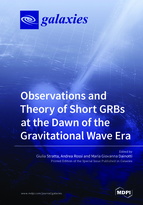Observations and Theory of Short GRBs at the Dawn of the Gravitational Wave Era
A special issue of Galaxies (ISSN 2075-4434).
Deadline for manuscript submissions: closed (31 October 2018) | Viewed by 11799
Special Issue Editors
Interests: X-ray astronomy; gamma ray astronomy; gamma ray bursts; gravitational wave sources; X/gamma-ray instrumentation
Interests: gamma-ray bursts; gravitational waves
2. INAF-OAS Bologna, via Gobetti 93, 40129 Bologna, Italy
3. Astronomical Observatory, Jagiellonian University, ul. Orla 171, 31-244 Krakòw, Poland
Interests: gamma-ray bursts; cosmology
Special Issue Information
Dear Colleagues,
A new era of astronomy started in August 2017, with the simultaneous detection of a short GRB and a gravitational wave event, as the result of the coalescence of a binary neutron star system (GRB170817/GW170817, Abbott et al. 2017a). Moreover, a macronova/kilonova event related to the same progenitor was unprecedently observed over the entire optical/NIR spectral range and over an extended temporal period (Abbott et al. 2017b). Thus, this is the perfect timing for further investigating the origin of short GRBs, their observational properties and progenitor nature.
Some peculiar features of GRB170817 as its proximity (by far the nearest short GRB detected so far), its moderate/low photon flux, the lack of neutrinos detection, and the lack of a detection of a clear X-ray afterglow soon after the burst, are in favour of an observer line of sight slightly off-axis with respect to the GRB jet axis.
In this Special Issue, we aim to collect both original works and review papers on the properties of short GRBs (e.g., jet opening angles and structures, population density, host galaxies, on- and off-axis afterglows), enlightened by the recent GW170817/GRB170817 association and corroborated by the forthcoming new observational run of Advanced LIGO and Advanced Virgo in fall 2018.
Key topics are:
- Detection rates of short GRBs with present and future missions
- Observations of short GRBs, their afterglows, and those with extended emission
- Estimations and measurements of short GRB energetics
- Theory and simulations of short GRBs and their connection with observations
- The host galaxies of short GRBs as probes of their progenitor properties
- The immediate vs. long-term impact of short GRBs/GWs simultaneous observations
- Kilonova and gravitational wave emissions as counterparts of short GRBs
- Short GRB rate vs. star formation rate
Dr. Giulia Stratta
Dr. Andrea Rossi
Dr. Maria Giovanna Dainotti
Guest Editors
Manuscript Submission Information
Manuscripts should be submitted online at www.mdpi.com by registering and logging in to this website. Once you are registered, click here to go to the submission form. Manuscripts can be submitted until the deadline. All submissions that pass pre-check are peer-reviewed. Accepted papers will be published continuously in the journal (as soon as accepted) and will be listed together on the special issue website. Research articles, review articles as well as short communications are invited. For planned papers, a title and short abstract (about 100 words) can be sent to the Editorial Office for announcement on this website.
Submitted manuscripts should not have been published previously, nor be under consideration for publication elsewhere (except conference proceedings papers). All manuscripts are thoroughly refereed through a single-blind peer-review process. A guide for authors and other relevant information for submission of manuscripts is available on the Instructions for Authors page. Galaxies is an international peer-reviewed open access semimonthly journal published by MDPI.
Please visit the Instructions for Authors page before submitting a manuscript. The Article Processing Charge (APC) for publication in this open access journal is 1400 CHF (Swiss Francs). Submitted papers should be well formatted and use good English. Authors may use MDPI's English editing service prior to publication or during author revisions.
References:
- Abbott, B.P.; Abbott, R.; Abbott, T.D.; Acernese, F.; Ackley, K.; Adams, C.; Adams, T.; Addesso, P.; Adhikari, R.X.; Adya, V.B. Gravitational Waves and Gamma-Rays from a Binary Neutron Star Merger: GW170817 and GRB 170817A. Astrophys. J. Lett. 2017, 848, L13.
- Abbott, B.P.; Abbott, R.; Abbott, T.D.; Acernese, F.; Ackley, K.; Adams, C.; Adams, T.; Addesso, P.; Adhikari, R.X.; Adya, V.B. Multi-messenger Observations of a Binary Neutron Star Merger. Astrophys. J. Lett. 2017, 848, L12.
Keywords
- short Gamma-ray Bursts: physics, progenitors, host galaxies
- gravitational waves
- star formation rate
- neutron star binary mergers
- kilonovae







